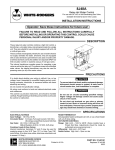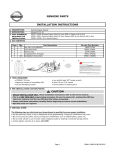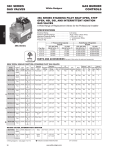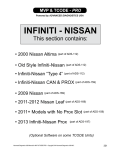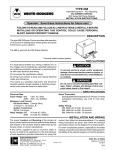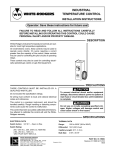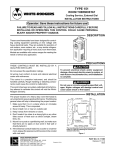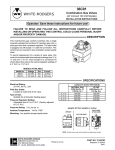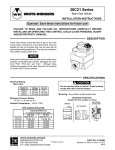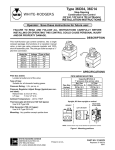Download White Rodgers 36C53 User's Manual
Transcript
36C53 Combination Gas Valves WHITE-RODGERS (24 Volt Model) INSTALLATION INSTRUCTIONS Operator: Save these instructions for future use! FAILURE TO READ AND FOLLOW ALL INSTRUCTIONS CAREFULLY BEFORE INSTALLING OR OPERATING THIS CONTROL COULD CAUSE PERSONAL INJURY AND/OR PROPERTY DAMAGE. O PIL ON This model features a slow opening main valve that provides a softer ignition and E.C.O. connections. OFF The multi-function gas controls combine into a single package the functions of 3-position gas cock, main gas valve, pressure regulator and 100% shut-off automatic pilot. The pilot gas outlet accepts a 1⁄4” pilot line connection. T DESCRIPTION E.C.O To permit replacement of a variety of valve sizes, some models are furnished with two reducer bushings (two 3⁄4” to 1⁄2”). Also included is an E.C.O. jumper wire that allows this valve to be used on an installation without electrical cut off device. SPECIFICATIONS Electrical Rating: Voltage: 24 Volts, (30 Volts Max.), 60 Hz. Current Rating: 0.23 Amps PIPE SIZES/CAPACITIES Type of Gas Natural Gas Pipe Size (inches) Pressure Rating: 1⁄2 lb. per sq. in. (14” W.C.) 1⁄2” x 3⁄8” x 1⁄2” 1⁄2” x 3⁄4” 3⁄4” x 3⁄4” 1⁄2” Pressure Regulator Setting: Adjustable from 2.5 to 5.0" W.C. (Factory preset for 3.5" W.C.) Ambient Temperature: -40° to 175°F Capacity (BTU/hr) at 1” pressure drop across valve Nat. Gas LP Gas (1000 BTU/cu. ft., (2500 BTU/cu. ft., 64 Sp. Gr.) 1.53 Sp. Gr.) 100,000 162,000 230,000 372,600 230,000 372,600 280,000 453,600 Upright, 90° from upright or vertical Thermocouple: INLET BOSS UP OR DOWN UPRIGHT 30 millivolt type LEFT OR RIGHT CONTENTS 1 1 2 2 NOTE: Control shown may not be identical to replacement control. 4 Figure 1. Gas valve mounting positions 5 WHITE-RODGERS DIVISION EMERSON ELECTRIC CO. 9797 REAVIS ROAD, ST. LOUIS, MO 63123-5398 (314) 577-1300, FAX (314) 577-1517 9999 HWY. 48, Markham, ONT, L3P 3J3 (905) 475-4653, FAX (905) 475-4625 ON OFF Description ......................................................... Specifications ..................................................... Precautions ........................................................ Installation .......................................................... Main Piping Connection Pilot Gas Connection Energy Cut Off (E.C.O.) Connection Thermocouple Connection System Wiring Adjustment ......................................................... Pilot Gas Adjustment Pressure Regulator Adjustment Pilot Lighting Instructions and Precautions ........ PART NO. 37-5825B Printed in U.S.A. Replaces 37-5825A 0024 SPECIFICATIONS DO NOT BEGIN INSTALLATION UNTIL YOU READ THE FOLLOWING PRECAUTIONS. ! WARNING If you do not follow these instructions exactly, a fire or explosion may result, causing property damage, personal injury or loss of life. 1. Failure to turn off electric or main gas supply to heating system could cause personal injury and/or property damage by shock, gas suffocation, fire, and/or explosion. 4. DO NOT USE WIRE JUMPER on pilot systems, such as standing pilot, proven pilot, or spark-to-pilot ignition–a fire and/or explosion may result. 2. Do not use this control on circuits exceeding specified voltage. Higher voltage will damage the control and may cause shock or fire hazard. 5. Do not use a control set for natural gas with LP gas, or a control set for LP gas with natural gas. Personal injury and/or property damage, gas suffocation, fire, and/or explosion may result. 3. NEVER USE FLAME OR ANY KIND OF SPARK TO CHECK FOR GAS LEAKS–COULD CAUSE FIRE AND/OR EXPLOSION. ! CAUTION 1. Do not short out terminals on gas valve or primary control to test. Short or incorrect wiring can cause equipment damage, property damage, and/or personal injury. 2. This control is not intended for use in locations where it may come in direct contact with water. Suitable protection must be provided to shield the control from exposure to water (dripping, spraying, rain, etc.). INSTALLATION 5. Apply pipe joint compound (pipe dope) or teflon tape that is approved for all gases, only to the male threads of the pipe joints. DO NOT apply compound or teflon tape to the first two threads (see fig. 1 for typical piping connections). 6. If you are using a vise or open-end wrench to hold the valve while installing piping, do not tighten excessively, as this may damage the valve. 7. If additional clearance for the gas cock knob is required when installing the new valve in an existing system, rotate the knob to the position between ON and OFF. Depress the knob while turning the valve. The knob will depress only while in this position. 8. See SYSTEM WIRING when making electrical connections. After all gas and electrical connections are completed, turn gas on and check for gas leaks with leak detection solution or soap suds. Bubbles forming indicate a leak. SHUT OFF GAS AND FIX ALL LEAKS IMMEDIATELY. MAIN PIPING CONNECTIONS NOTE All piping must comply with local codes, ordinances, and/or national fuel gas codes. 1. Turn off electrical power to the system at the fuse box or circuit breaker. Also turn off the main gas supply. 2. If replacing an existing valve, disconnect all plumbing and electrical connections from the old control. 3. The control may be installed in any orientation except upside down. The arrow on the valve indicates the direction of gas flow through the control. 4. You should use new pipe that is properly chamfered, reamed, and free of burrs and chips. If you are using old pipe, be sure it is clean and free of rust, scale, burrs, chips, and old pipe joint compound. 2 INSTALLATION (cont’d) THERMOCOUPLE CONNECTION Drop Horizontal The thermocouple connection should be clean to ensure good electrical contact. NOTE: Always Include A Drip Leg In Piping Riser Run the thermocouple nut into the power unit tapping as far as possible by hand. Then use a small wrench to set the nut with a 1⁄4 to 1⁄2 additional turn. Do not overtighten. Gas Valve Connect leads from E.C.O. terminals to E.C.O. device on furnace. Test E.C.O. device for continuity. If there is no continuity, power unit will not hold in. 3 in. minimum Drop Tubing Gas Supply If the furnace does not have an E.C.O. device, use the jumper provided in the pack. Gas Valve Riser Horizontal SYSTEM WIRING ! CAUTION Gas Valve 3 in. minimum Piped Gas Supply To prevent electrical shock and/or equipment damage, disconnect electrical power to system at main fuse or circuit breaker box until installation is complete. 3 in. minimum Piped Gas Supply Figure 2. Typical gas valve piping NOTE PILOT GAS CONNECTION All wiring should be installed in accordance with local and national electrical codes and ordinances. Install fitting into pilot gas outlet (see fig. 2), turning until finger-tight. Insert clean, deburred tubing all the way through the fitting. While holding the tubing securely, slowly tighten fitting until you feel a slight "give". Tighten the fitting an additional 1 1⁄2 turns. Always check that the electrical power supply used agrees with the voltage and frequency shown on the gas control. Pilot Gas Outlet PILOT The typical wiring diagram shows only the terminal identification and wiring hook up. Always refer to wiring instructions provided by Equipment Manufacturer for system hookup operation. PRESS THERMOSTAT TAP GAS VALVE TERMINAL PANEL Gas Outlet HIGH LIMIT TH TH-TR TR HOT LINE 24 VAC Figure 3. Gas valve side view TRANSFORMER Figure 4. Wiring for 36C53 ENERGY CUT OFF (E.C.O.) CONNECTION THERMOCOUPLE CONNECTION A five-function valve uses the 2 E.C.O. terminals that are connected to the magnetic assembly where the thermocouple connects to the 36C valve line interrupter. An E.C.O. device is mounted in the furnace near the limit control and a lead assembly is connected to the E.C.O. terminals on the 36C valve. E.C.O. DEVICE LEAD ASSEMBLY E.C.O. TERMINALS Figure 5. Wiring for Energy Cut-Off (E.C.O.) connection 3 INSTALLATION (cont’d) PILOT FLAME ADJUSTMENT PRESSURE REGULATOR ADJUSTMENT If the pilot flame is low and does not engulf the bulb of the mercury flame sensor, the system will not energize the main valve. If pilot gas pressure is too high, gas will sputter past the ignition electrode, and may not ignite. High pilot gas pressure may also cause the flame to lift off the burner, causing the flame sensor bulb to sense "low" heat. The pressure regulator has been factory adjusted (see control for specific setting). Although additional adjustments will not normally be necessary, you may adjust the regulator. Do not force the adjusting screw beyond the limits that it can easily be adjusted. To adjust the pilot gas pressure, remove the cover screw (see fig. 6). To REDUCE pilot pressure, turn the pilot adjust screw (beneath the cover screw) clockwise. To INCREASE pilot pressure, turn the pilot adjust screw counterclockwise. Replace and tighten cover screw. 1. Energize valve to ignite main burner. 2. Remove "Reg. Adj." cover screw (see fig. 7). 3. To DECREASE outlet pressure, turn the adjusting screw (beneath the cover screw) counterclockwise. To INCREASE outlet pressure, turn the adjusting screw clockwise. 4. Replace the cover screw. Cycle the valve two or three times to verify regulator setting. Pilot Adjust Cover Screw Gasket REGULATOR ADJUSTING COVER SCREW OFF PIL OT PILOT ADJUST COVER SCREW ON Pilot Adjust Screw Figure 6. Pilot Flame Adjustment Figure 7. Pressure regulator adjustment 4 PILOT LIGHTING INSTRUCTIONS AND PRECAUTIONS FOR YOUR SAFETY READ BEFORE LIGHTING ! If you do not follow these instructions exactly, a fire or explosion may result causing property damage, personal injury or loss of life. WARNING A. This appliance has a pilot that must be lighted by hand. When lighting the pilot, follow these instructions exactly. • Immediately call you gas supplier from a neighbor's phone. Follow the gas supplier's instructions. B. BEFORE LIGHTING, smell all around the appliance area for gas. Be sure to smell next to the floor because some gas is heavier than air and will settle on the floor. • If you cannot reach your gas supplier, call the fire department. C. Use only your hand to push in or turn the gas control knob. Never use tools. If the knob will not push in or turn by hand, don't try to repair it; call a qualified service technician. Force or attempted repair may result in a fire of explosion. FOR YOUR SAFETY "WHAT TO DO IF YOU SMELL GAS" • Do not try to light any appliance. • Do not touch any electrical switch; do not use any phone in your building. D. Do not use this appliance if any part has been under water. Immediately call a qualified service technician to inspect the appliance and to replace any part of the control system and any gas control that has been under water. LIGHTING INSTRUCTIONS 7. Find pilot - follow small metal tubes from gas control. 1. STOP! Read the precautionary information above. 2. Set the thermostat to lowest setting. PILOT BURNER 3. Turn off all electrical power to the appliance. 8. Turn knob on gas control counterclockwise to PILOT. PI OFF LO T 4. Depress gas control knob slightly and turn clockwise to OFF (see fig. 7). If knob is in ON, turn clockwise to PILOT, then depress knob slightly and turn clockwise to OFF. ON THERMOCOUPLE 9. Depress control knob all the way and hold in. Immediately light the pilot with a match. Continue to hold the control knob down for about one (1) minute after the pilot is lit. Release knob and it will pop back up. Pilot should remain lit. If it goes out, repeat steps 4, 5, 8, and 9. Gas Control Knob • If knob does not pop up when released, turn clockwise to OFF, stop and immediately call your service technician or gas supplier. • If the pilot will not stay lit after several tries, turn the gas control knob to OFF and call your service technician or gas supplier. 36C Series NOTE: Knob cannot be turned from PILOT to OFF unless knob is depressed slightly. Do not use tools or excessive force. 10. Replace pilot access panel(s). 5. Wait fifteen (15) minutes to clear out any gas. If you then smell gas, STOP! Follow B in the precautionary information above. If you don't smell gas, go to next step. 11. Turn gas control knob counterclockwise to ON. 12. Turn on all electrical power to the appliance. 6. Remove the pilot access panel(s) located under the gas control unit. 13. Set thermostat to desired setting. TO TURN OFF GAS TO APPLIANCE 1. Set the thermostat to lowest setting. 3. Turn gas control knob clockwise to PILOT. 2. Turn off all electrical power to the appliance if service is to be performed. 4. Depress gas control knob slightly and turn clockwise to OFF. Do not use tools or excessive force. OFF PIL ON OT Gas Cock Knob Indicator Figure 8. Gas Cock Knob 5 If you need further information about this product, please write to White-Rodgers Division, Emerson Electric Co. 9797 Reavis Road St. Louis, MO 63123-5398 Attention: Technical Service Department 9999 HWY. 48 Markham, ONT, L3P 3J3 Attention: Technical Service Department






